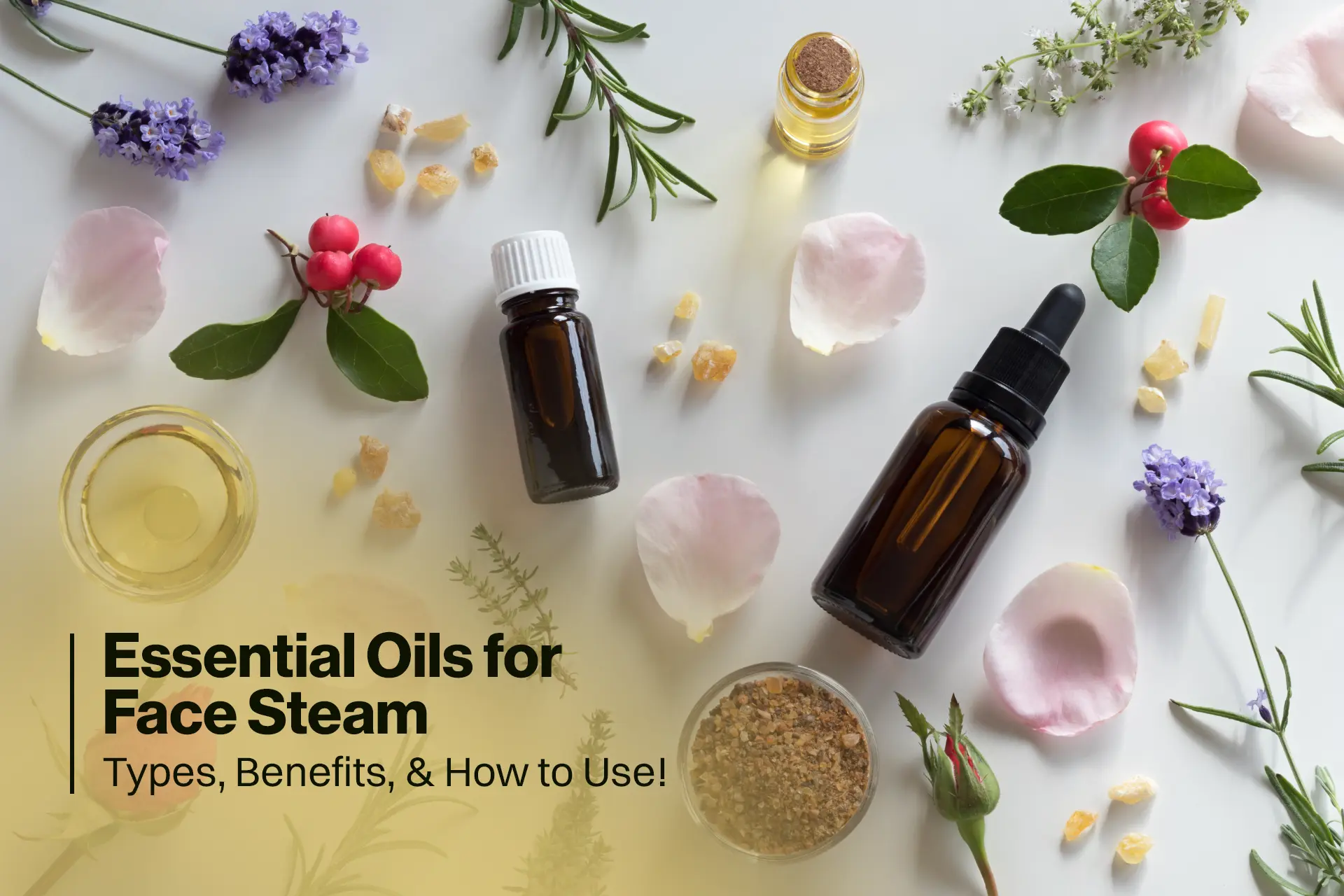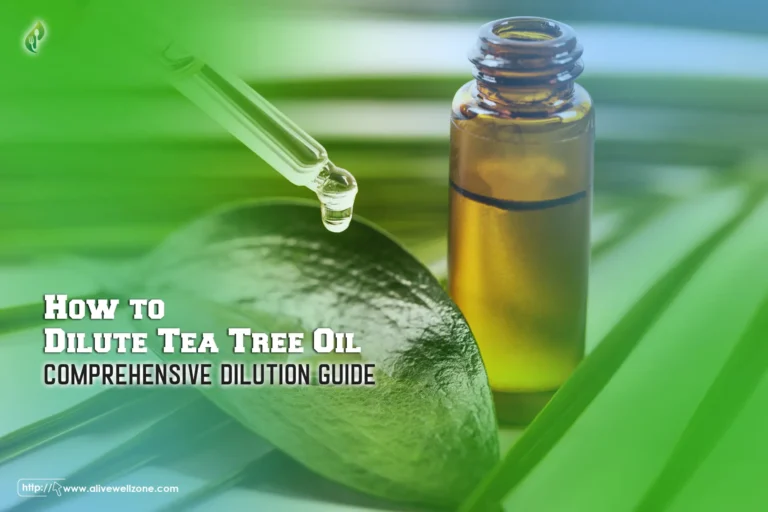
Last Updated on August 30, 2025 by Helena Akter
Are you tired of dull, lifeless skin? Have you tried countless skincare products without seeing the results you want? If so, you’re not alone. Many people struggle to achieve a healthy, radiant complexion.
Face steaming is a simple yet effective way to improve your skin’s appearance. When combined with essential oils, it can provide you with a natural and nourishing treatment.
With that thought, we’ll explore the best essential oils for face steam and how to choose one, and most importantly, how to properly use it to get the results you expect.
How Does Steaming Help Your Skin?
Face steaming can improve skin condition by making it clean, soft, and hydrated. You’ll get a more youthful and glowy skin. Here’s how it can help—
Cleans the Skin
The human face has tiny pores on the skin, including the facial ones. It’s a tiny opening that releases oil and sweat.
However, oil, dead skin cells, and dirt can get trapped. It can result in blackheads, whiteheads, or pimples.
Now, steaming with essential oils can widen the pores. This makes it easier to remove dirt, oil, and other impurities. Thus, your skin looks fresher, brighter, and better.
Promotes Blood Circulation
Blood flow maintains the nutrition and temperature of the skin. If your face doesn’t have enough blood flow, it can be short of necessary nutrition.
Ultimately, you may have dull, tired-looking skin with uneven texture and tone. Do you want it? No, right?
Steaming can help maintain proper blood flow to the face.
Tackles Trapped Sebum
Sebum is your skin-produced oil. It can get trapped in the pores. When steaming opens up the pores, the oil becomes easy to clean.
Lavender, tea tree, etc., are essential oils that can control oil production and help you get balanced skin.
Improves Skin Hydration
Steaming softens facial skin and widens pores. It allows skin to receive more moisture and feel soft and plump.
Adding essential oils can increase the effect by providing additional hydration, helping you get a smoother complexion.
Fights Acne-Causing Bacteria
Do you know the primary culprit that causes acne on your beautiful face? It’s the clogged pores. Steaming opens up the pores and helps remove the clog.
In fact, essential oils have antibacterial properties that target acne-causing germs. It reduces your chance of getting frequent acne.
Increases Collagen Production
You’ve already read about how steaming increases blood flow to the face. This increased circulation stimulates collagen production.
Collagen boosts new cell growth and replaces dead skin cells. Plus, it keeps you looking fresh, young, and happy.
Softens Facial Skin
The warmth and moisture make the skin more supple and smooth. Essential oils, like rose or chamomile, can increase the effect by improving hydration. It makes your skin feel softer and brighter.
15 Essential Oils for Face Steaming for Healthy Skin
Essential oils are made from different plants. They have a unique flavor and fragrance. Also, they work differently to maintain skin health.
For your convenience, here are the most popular choices of essential oils for face steaming:
1. Tea Tree Oil
Tea tree is made, as the name suggests, from tea tree. It’s a rather budget-friendly choice with an abundance of benefits. Plus, it has powerful anti-bacterial properties.
The oil is popularly used in alternative and complementary treatments.
This essential oil is a good cleaner that soothes the skin with anti-inflammation properties. It removes acne-causing germs and keeps you looking fresh.
Besides, tea tree oil will help purify skin and increase the benefits of the steam.
In addition, you can use the oil directly on the skin. In that case, you must dilute tea tree oil first, as undiluted oil can cause irritation, skin redness, and burning sensations.
2. Black Seed Oil
This essential oil is made from the seeds of the Nigella sativa plant. It’s known for being rich in antioxidant and anti-inflammatory properties.
You can mix the oil with steaming water to reduce inflammation and redness. It can also soothe your irritated skin. Plus, black seed oil erases fine lines, fights acne, removes dark spots, and improves your overall skin tone.
However, avoid using more than a few drops as it can cause nausea, bloating, and allergic reactions.
3. Orange Oil
Orange is rich in nutrients. A lot of the benefits of the fruit are still preserved when you extract its oil from the rind. It has a fresh, energizing scent and vitamin C, with multiple skin benefits.
When you use orange oil with steaming, it makes your skin soft, bright, fresh, and —
- Fights acne
- Controls oil
- Reduces dark spots
- Erases aging signs from the face.
4. Eucalyptus Oil
The oil is made from the leaves and branch tops of eucalyptus plants. It’s rich with a complex mixture of a variety of oxides, ethers, alcohols, esters, and other compounds.
Besides, Eucalyptus oil is good for deep cleaning. The steam can reduce oil from the skin and regulate sebum production. It helps you stay acne-free.
Plus, eucalyptus can reduce allergic reactions in the skin and relieve you from itching sensation, redness, and face swelling.
5. Lavender Oil
Known for its sweet scent, lavender also has skin benefits.
It contains components like linalool, lavandulol, geraniol, or eucalyptol. These components have anti-inflammatory, antimicrobial, and soothing effects.
You can steam your face with lavender to soothe irritation, reduce redness, and even out your complexion. Lavender also removes acne, minimizes the risk of infection, and maintains skin oil balance.
With regular lavender oil steaming, your skin will look fresh and delighted.
6. Geranium Oil
Geranium is an important ingredient in perfumes and cosmetics.
You can also use it for face steaming. The primary content of the oil is citronellol. It’s a monoterpene alcohol that reduces skin infection.
Use the oil for steaming after a tiresome day. It’ll clean the skin and remove dirt, oil, and other impurities.
Plus, regular cleaning will keep acne and other facial marks away. Your face retains its natural glow and appears healthy and bright.
7. Chamomile Oil
If you’ve sensitive skin, chamomile oil can be a good choice. Well, it’s suitable for other skin types as well. Now, the oil contains many components, including —
- Luteolin
- Rutin
- Bisoprolol
- Matricin
- Apigenin, etc.
If you’re prone to skin allergies or inflammation, try steaming with chamomile oil. Its anti-inflammatory properties will provide a calming effect. Plus, the oil removes pollutants and improves your blood circulation.
Also, the vapor of the oil increases new cell growth and removes dead cells. Ultimately, you get smooth and soft skin.
8. Peppermint Oil
The oil washes the face with antiseptic and antibacterial effects. Its active components are —
- Menthol
- Menthone
- Menthyl acetate
- Camphor
- Limonene, and others.
The presence of menthol provides a calming sensation. Like other essential oils, peppermint also widens the pores and helps them clean. However, don’t use it on your children’s faces because the inhalation of menthol can cause side effects to them.
9. Juniper Berry Oil
Juniper Berry Oil comes from the berries of the Juniperus communis plant. It has a woody, pine-like scent. The oil also contains compounds like alpha-pinene, beta-pinene, and sabinene.
Aside from its distinctive scent, these components also add to its therapeutic effects.
The oil is especially helpful in detoxification. It establishes a balance in the presence of oil in the skin, reverses aging signs, soothes irritation, and tightens pores.
That way, it gives you a smoother complexion by promoting skin clarity. Remember, steaming is the best method of consuming the oil.
10. Carrot Seed Oil
Carrot Seed Oil is extracted from the seeds of the Daucus Carota plant. The scent of the oil is warming and earthy. It’s popularly used in skincare for its nourishing properties.
Steaming carrot seed oil cleans the pores of the face and reduces the risk of acne. It also treats dryness and gives you a radiant skin. Like any other essential oils, it should be diluted too before applying.
11. Lemongrass Oil
Lemongrass Oil comes from the leaves of Cymbopogon citratus. It’s known for its fresh, citrusy aroma and its use in skincare for its purifying properties.
Plus, the oil is popular for treating many skin diseases. Fighting pimple-causing bacteria is a major benefit of using the oil. Other benefits of the oil are —
- It provides antioxidants
- Combats and reduces fungal infections.
- Provides a relaxing effect.
- The sweet smell can also help with headaches.
12. Clove Oil
Are you familiar with Syzygium Aromaticum? In the USA, it’s more commonly known as clove. Cloves are full of antioxidants that help your body fight free radicals. It saves your skin cells from getting damaged.
Plus, Clove oil is good for treating inflammation and acne. It contains antimicrobial properties. Also, it’s a natural antifungal and antibacterial compound.
In addition to removing harmful bacteria, clove oil prevents and treats your dark spots.
13. Frankincense Oil
Frankincense oil has a rich, earthy aroma with a rich history of being used in both spiritual rituals and skincare. The oil is extracted from the resin of the Boswellia tree.
It has many other uses, like a natural bug repellent, eyeliner, stress reliever, etc.
Anyway, it’s a good choice to use frankincense oil for steaming. It can reduce your aging marks and improve skin elasticity and tone.
The oil also has a calming effect on the skin. This makes it a popular choice for reducing fine lines and wrinkles.
14. Oregano Oil
Oregano is a natural antibiotic. It contains carvacrol, thymol, and rosmarinic acid. The presence of powerful antioxidants makes it a savior against free radical damage.
Plus, the oil has a strong, herbal scent that makes steaming more enjoyable.
When used with face steaming, Oregano Oil helps cleanse the skin by targeting acne-causing bacteria. It also reduces inflammation and soothes irritated skin.
The steam boosts the oil’s ability to penetrate the pores. Thus, it makes your skin feel refreshed and revitalized.
15. Rosemary Oil
Rosemary oil can be light yellow or colorless. It’s a free-flowing liquid with woody and balsamic notes. The primary chemical components are- a-pinene, b-pinene, camphor, camphene, etc.
Steaming rosemary oil improves blood circulation and promotes a healthy glow. It has antibacterial properties to clean your skin and reduce acne.
Plus, this oil is a natural stress reliever. It helps you with anxiety, headaches, and stress and makes you feel fresh and better.
How to Choose the Right Essential Oil?
Not all of us share the same skin problem. Skin types vary from person to person. You’ve to remember this when choosing an essential oil.
Plus, different oils are more suitable for different skin- dry, oily, or sensitive. So, here are some suggestions for the ideal tea for different skin types.
- Dry Skin: Dry skin often feels tight, rough, and flaky. They quickly become dull and get visible fine lines. You need to use essential oils that are good for moisturizing. So, lavender, chamomile, frankincense, rosemary, and carrot seed, etc., are the best for dry skin.
- Oily Skin: Since oily skins look shiny and feel greasy, you need something rich in astringent and antibacterial properties. These properties control excess oil and prevent breakouts. Tea tree, rosemary, and lavender will be ideal choices for your oily skin.
- Sensitive Skin: Such skin is prone to irritation, redness, itching, and reactions to products easily. If you’ve sensitive skin, you need to be careful with the oil choice. Choose something soothing and anti-inflammatory, like tea tree oil, lavender, eucalyptus, and lemongrass.
- Acne-prone Skin: You may experience frequent breakouts, clogged pores, and inflammation. Try tea tree oil, lemongrass, or lavender oil. They have anti-bacterial and anti-inflammatory properties to reduce acne.
- Skin rash: For skin rash treatment, you’ve many options to choose from. Lavender, geranium, eucalyptus, lemongrass, and orange oil can be applied.
- For Pigmentation: You may experience dark spots, uneven skin tone, or discoloration. It’s best to treat the problem with brightening and skin-regenerating oils such as carrot seed, orange oil, frankincense, lavender, geranium, lemongrass, etc.
Preparation to Take Before Face Steaming
Face steam with essential oils is a good approach for skin care. However, you should make some preparations first. It’ll maximize the benefits and help you look better, fresher, and more charming.
- Drink some water before steaming. It’ll hydrate the skin before getting exposed to the heat. It maintains body temperature and prevents dehydration. Besides, it’s one of the healthy habits for a positive lifestyle.
- Wash your face properly. Use a gentle cleanser containing an exfoliator to remove dead skin cells.
- Don’t use any makeup before steaming. Skin pores get wider during the process. Chemical components of the makeup may enter the skin, which can be harmful.
- Keep face masks, toner, and moisturizer neat at hand. Applying them after steaming is beneficial for the skin.
How to Use Face Steaming Oil?
It’s an easy process to use essential oils with steam. You only have to perform the following easy steps —
- Buy your essential oil from a reliable source. Make sure to check reviews, product descriptions, and certifications.
- Boil a small bowl of water. You won’t need more than a few cups of water.
- Wash the face to remove dirt and makeup.
- Pour the water into the bowl you want to use for steaming. A ceramic bowl is usually the best choice.
- Now, add a few drops of essential oils to the water. Excessive oil use can cause irritation, redness, and a burning sensation.
- Drape a towel over the head and hold your face over the steaming water. Don’t go too close to the bowl. Stay at least 6 inches away. Increase the distance based on the water temperature.
- Keep your eyes closed and breathe deeply. Try steaming for up to 10 minutes.
Tips and Tricks to Follow After Face Steaming
Face steaming exposes your skin to heat. While it’s a healthy method, some additional practice can make it more beneficial. Try these tips after face steaming —
- Use an exfoliant or face mask. Since the pores have widened, the face mask will now easily remove dead skin cells and offer a deep clean.
- Use a toner, such as lemon juice or vinegar. It’ll close the pores again. This prevents dirt and oil from re-entering and clogging them.
- Finally, apply a moisturizer on the face. It’ll keep the skin hydrated since steaming dries out the skin. You can use coconut oil, jojoba oil, or argan oil.
- In case you’re having a dry mouth or dry throat sensation, try herbal trees or some other foods that help dry your mouth naturally.
Cautions to Maintain When Face Steaming
If you prefer DIY face steaming, then make a list of cautions to maintain. This will help prevent accidents from happening.
- Make the water warm, not burning hot. Too hot water can cause burns or irritation.
- Don’t overdo it. A 10-15 minute session of face steaming is healthy enough. Overdoing it can cause dehydration and excessive skin dryness.
- Maintain a safe distance from the water. Hold your face at a comfortable distance that doesn’t make you feel burning.
- Use only a few drops of essential oil.
- Consult with a doctor or dermatologist if you’ve sensitive or other skin conditions.
Final Words
We’ve explored how essential oils can boost the benefits of face steaming, giving you more youthful and glowing skin.
But it’s important to choose the right oils and take necessary precautions. This will help you avoid any issues and make the experience even better.
Remember to follow the tips mentioned above to get the most out of your face-steaming routine. With regular use, you’ll start seeing noticeable improvements in your skin.
So, give it a try and enjoy the transformation!
Can you include steaming with essential oil roll-ons?
Yes, you can use essential oil roll-ons before steaming. Apply them directly to your skin. However, use them sparingly and ensure they’re diluted properly.
Should I put oil on my face before steaming?
No, you don’t have to put oil on the face before steaming. Steam will make the oil more difficult to remove, and it may clog pores. Just wash your face thoroughly before steaming.
Can I use honey after steaming my face?
Yes, you can use honey after steaming your face. Honey is a natural moisturizer and has soothing and anti-bacterial properties. Apply it to your face after steaming to help hydrate and calm the skin. This also improves the smoothness and complexion of the skin.
Can I use vitamin C serum after steaming?
Yes, using a vitamin C serum after steaming is beneficial. The steam opens your pores and allows better absorption of the serum. It brightens the skin, reduces dark spots, and protects against environmental damage.
Is it okay to steam your face every day?
No, it isn’t. Though the benefits of face steaming are luring, you needn’t be greedy. Steaming daily can cause skin dehydration and dryness. Besides, the pores won’t have enough time to close properly.







